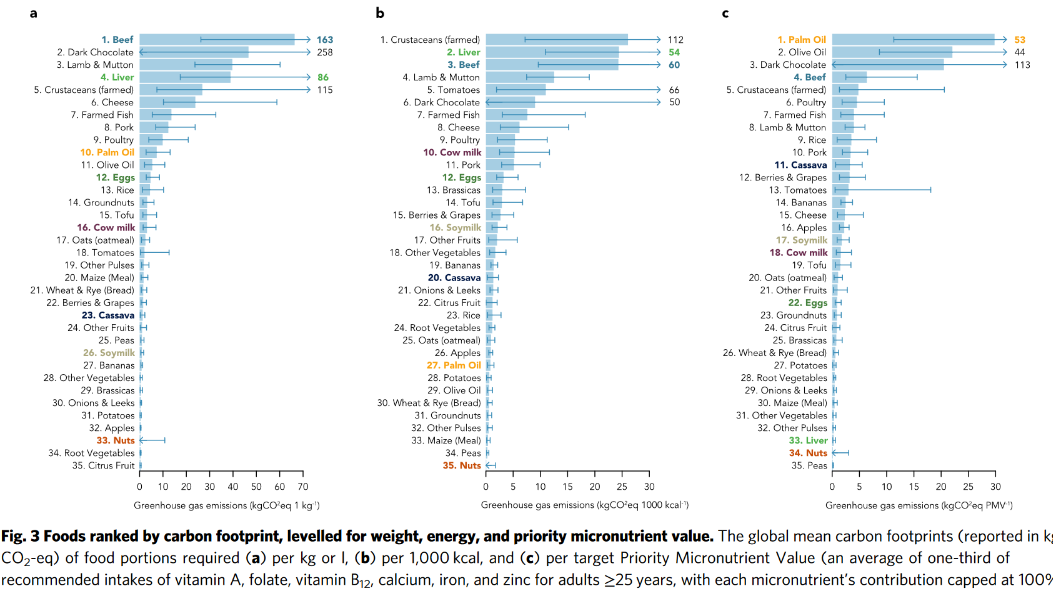- cross-posted to:
- collapse@sopuli.xyz
- climate_lm@slrpnk.net
- cross-posted to:
- collapse@sopuli.xyz
- climate_lm@slrpnk.net
Animal ag is a method of refining surplus safe, healthy, sustainable plant products into addictive, harmful, cruel, and violent luxury goods. It adds nothing, it only takes away and creates scarcity.
That is a verifiable lie.
I disagree, but I’m open to having my mind changed.
I don’t suppose you saw my post about meat and the environment? https://hackertalks.com/post/8020602
I found these two paper’s from the episode particularly interesting about the environmental impacts of ruminants and nutritional arbitrage of a PBF diet (the proposed replacement for all pasture land).
Ruminants have exist before humans, they are not hurting the environment, they are the environment. Sustainable regenerative ruminant based agriculture is key to maximizing the output of the land.
https://doi.org/10.1073/pnas.1707322114 Nutritional and greenhouse gas impacts of removing animals from US agriculture
only reduced total US GHG by 2.6 percentage units.
This assessment suggests that removing animals from US agriculture would reduce agricultural GHG emissions, but would also create a food supply incapable of supporting the US population’s nutritional requirements.
Interestingly on this model, calories and carbohydrates would increase but there would be more nutritional gaps.
http://dx.doi.org/10.1038/s43247-023-00945-9 Levelling foods for priority micronutrient value can provide more meaningful environmental footprint comparisons

"Use of agricultural land for livestock
It’s often thought that livestock farming consumes land that could support crops, but a large portion of agricultural land is unsuitable for other uses. Livestock can convert non-arable land into nutritious food while also improving soil health."
This is a red herring. Livestock takes up 80% of agricultural land while providing only 20% of the world’s supply of calories. Removing livestock would free up a significant amount of crop growing land (where crops are currently grown for livestock consumption,) which would first be repurposed for human consumption. Most pasture land could be rewilded without affecting the supply of calories to humans.
Improvements to soil health are meaningless where in its natural state, that land would take the form of forests, peatlands etc. which can sequester huge amounts of carbon.
Irrelevant aside:
Removing livestock would free up a significant amount of crop growing land (where crops are currently grown for livestock consumption,) which would first be repurposed for human consumption.
“Human consumption” here couldn’t mean eating. There is no way we could eat all the food we currently grow for ourselves, plus all the food we grow for livestock. Meat obviously consumes many times the calories it produces. The surplus plants could be used for energy generation (low tech solar), pharm, industrial products, etc.
If livestock was restricted to non-arable land and not fed any arable crops : it would be a net positive, no?
No. Without addressing water sources, if livestock only produced carbon dioxide they might come close to net neutral, but the methane they produce is a huge component of their effect on the climate; that methane simply wouldn’t be a factor if the land were left fallow. They also engineer the land, preventing the growth of forest and creation of peat in areas where it would naturally occur.
The methane cycle is from the ruminates eating the grass, which is to say the microbes processing grass. The grass is going to grow with or without ruminates eating it, and microbes will process the grass all the same in a stomach or out on the grassland. I.e. the methane load is a function of the plant growth and not of the animals.
Is that not correct?
No, removing livestock will generally lead to increased vegetation and biodiversity, longer growth and more photosynthesis. There would be an increase in plant litter leading to increased microbial activity - releasing some carbon as CO2, and sequestering most of the rest in the soil.
Methane production would occur in anaerobic conditions (e.g. waterlogged or more compacted soil,) but nowhere near as efficiently as it does in the rumen of livestock.
Clearly the microbes in a ruminant’s gut are not the same as the ones in the litter layer on top of the topsoil. For one thing, one would be aerobic and one would be anaerobic. I would not expect them to necessarily have the same byproducts.
The effort you are spending trying hard to find loopholes that allow you to continue consuming animals could be better spent changing your behaviour.
I find optimal health on a ASF diet for medical reasons. That is a requirement in my life, sorry, it’s not going to change.
I’m happy to talk about environmental stewardship and what would be the best way to maintain the planet.
Microbes exist outside of animals… that’s how they get into animals after all
Even in a Aerobic context biomass creates methane https://doi.org/10.5194/bg-5-937-2008
The natural cycle of nature will include methane, with or without ruminants
I find optimal health on a ASF diet for medical reasons. That is a requirement in my life, sorry, it’s not going to change.
ASF diet as in “the carnivore diet”? what are you even doing here
fine, whatever, do what you want, burden the environment as much as a handful of other people, commit wanton and careless cruelty and violence, whatever, but seriously, why are you here trying to pick holes in well-established research? you’re not going to change your behaviour either way, you just seem to want to have some kind of justification for your behaviour. if you feel guilty, you’re not going to fix it like this. and if you don’t, what is motivating you??
Did you actually read that paper? It’s talking about hundreds of nanograms of methane produced per gram of plant matter. The rumen produces about 20,000,000ng of methane per gram of grass.
I didn’t dive into the text or infographic but one thing that is immediately suspicious to me is the nutrient profile used for “leveling”. In particular it contains B12, but none of the foods listed even naturally contain meaningful levels of B12. B12 is created by microogranisms, not plants and not animals. The other two charts seem superficially to fully support the thesis of OP’s article. The third chart looks like pure fudge factor.
People cite B12 as evidence that vegan diets are not complete. And yet, vegans score much higher than consumers of the SAD on serum B12 levels. Meat-eaters are more deficient in B12 than vegans are. And yet it’s all you hear about…



